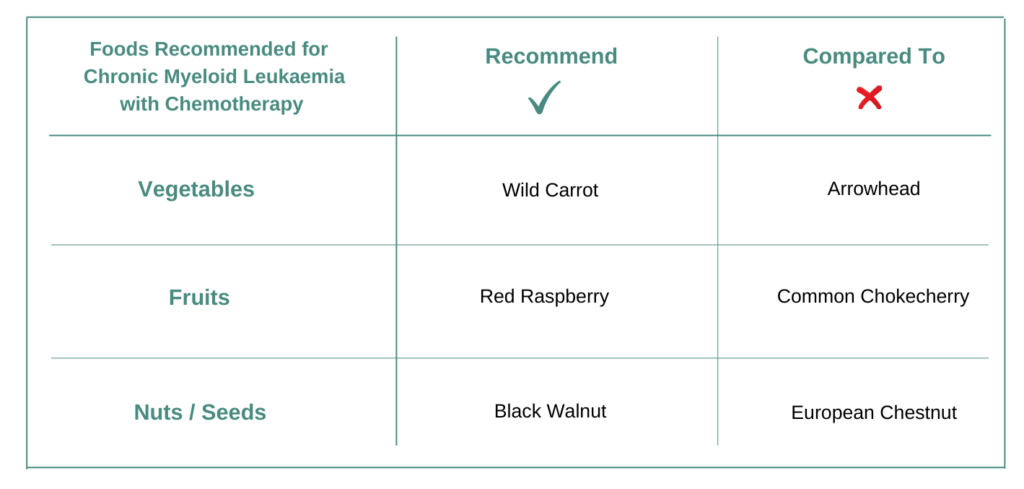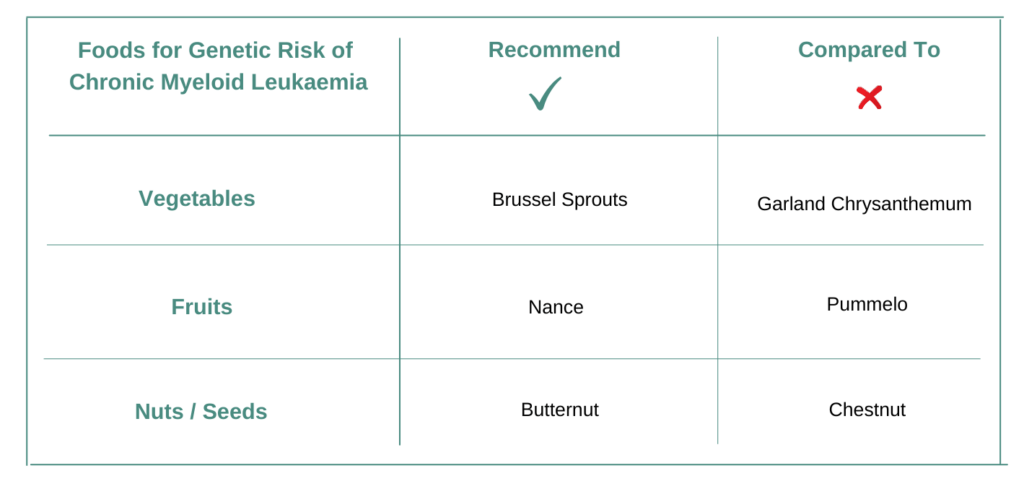Introduction
Foods for Chronic Myeloid Leukaemia should be personalized for each individual and also must adapt when cancer treatment or tumor genetic change. The personalization and adaptation must consider all the active ingredients or bioactives contained in different foods with respect to cancer tissue biology, genetics, treatments, lifestyle conditions and diet preferences. Hence while nutrition is one of the very important decisions for a cancer patient and individual at risk of cancer to make – how to choose foods to eat is not an easy task.
Chronic myeloid leukemia (CML) is a blood cancer that begins in the blood forming cells in the bone marrow. It is the most common leukemia in older adults. CML cancer cells contain an abnormal chromosomal defect called the Philadelphia chromosome, resulting in an abnormal gene fusion called BCR-ABL. This gene creates a protein that drives the uncontrollable growth of the cancer cells. This results in a large number of granulocytes, a type of white blood cells, in the bone marrow. Over time these immature blood cells called blasts accumulate in the bone marrow, making it difficult to produce normal red blood cells, white blood cells and platelets. This is a slow growing cancer and in most cases, there may not be any evident symptoms. However, the warning signs for chronic myeloid leukemia include fever, bone pain, fatigue, unexplained weight loss, easy bleeding, loss of appetite, night sweats, and an enlarged spleen. Chronic myeloid leukemia may cause symptoms of anemia causing persistent fatigue, paleness, shortness of breath; unexplained bleeding or bruising due to very low platelet count, frequent infections, and slow healing, all a result of a paucity of normal blood cells. Treatment options for chronic myeloid leukemia include targeted therapy to inhibit the BCR-ABL gene as the first line therapy. Other treatments include chemotherapy, interferon therapy, radiation therapy and stem cell transplant. With the advances in targeted and other treatment options, CML has a good prognosis with the 5-year survival rate for CML at 90%. In addition, supportive care with the right nutrition (foods and natural supplements) can help improve patients’ well-being.
For Chronic Myeloid Leukaemia does it matter what vegetables, fruits, nuts, seeds one eats?
A very common nutrition question asked by cancer patients and individuals at-genetic risk of cancer is – for cancers like Chronic Myeloid Leukaemia does it matter what foods I eat and which I do not? Or if I follow a plant-based diet is that enough for cancer like Chronic Myeloid Leukaemia?
For example does it matter if vegetable Wild Carrot is consumed more compared to Arrowhead? Does it make any difference if fruit Common Chokecherry is preferred over Red Raspberry? Also if similar choices are made for nuts/seeds like Black Walnut over European Chestnut and for pulses like Moth Bean over Yellow Wax Bean. And if what I eat matters – then how does one identify foods which are recommended for Chronic Myeloid Leukaemia and is it the same answer for everyone with the same diagnosis or genetic risk?
Yes! Foods you eat matters for Chronic Myeloid Leukaemia!
Food recommendations may not be the same for everyone and can be different even for the same diagnosis and genetic risk.

All foods (vegetables, fruits, nuts, seeds, pulses, oils etc.) and nutritional supplements are made up of more than one active molecular ingredient or bio-actives in different proportions and quantities. Each active ingredient has a unique mechanism of action – which can be activation or inhibition of different biochemical pathways. Simply stated foods and supplements which are recommended are those which do not cause an increase of molecular drivers of cancer but reduce them. Else those foods should not be recommended. Foods contain multiple active ingredients – hence when evaluating foods and supplements you need to consider the impact of all active ingredients cumulatively rather than individually.
For example Common Chokecherry contains active ingredients Apigenin, Curcumin, Daidzein, Lupeol, Formononetin. And Red Raspberry contains active ingredients Curcumin, Ellagic Acid, Lupeol, Daidzein, Quercetin and possibly others.
A common mistake made when deciding and choosing foods to eat for Chronic Myeloid Leukaemia – is to evaluate only selected active ingredients contained in foods and ignore the rest. Because different active ingredients contained in foods may have opposing effects on cancer drivers – you cannot cherry pick active ingredients in foods and supplements for making a nutrition decision for Chronic Myeloid Leukaemia.
YES – FOOD CHOICES MATTER FOR CANCER. NUTRITION DECISIONS MUST CONSIDER ALL ACTIVE INGREDIENTS OF FOODS.
Skills Needed for Nutrition Personalization for Chronic Myeloid Leukaemia?
Personalized nutrition for cancers like Chronic Myeloid Leukaemia consists of recommended foods / supplements; not recommended foods / supplements with example recipes which prioritize use of recommended foods. An example of personalized nutrition can be seen at this link.
Deciding which foods are recommended or not is extremely complicated, requiring expertise in Chronic Myeloid Leukaemia biology, food science, genetics, biochemistry along with good understanding of how cancer treatments work and associated vulnerabilities by which the treatments could stop being effective.
MINIMUM KNOWLEDGE EXPERTISE NEEDED FOR NUTRITION PERSONALIZATION FOR CANCER ARE: CANCER BIOLOGY, FOOD SCIENCE, CANCER TREATMENTS AND GENETICS.
Foods to Eat After Cancer Diagnosis!
No two cancers are the same. Go beyond the common nutrition guidelines for everyone and make personalized decisions about food and supplements with confidence.
Characteristics of cancers like Chronic Myeloid Leukaemia
All cancers like Chronic Myeloid Leukaemia can be characterized by a unique set of biochemical pathways – the signature pathways of Chronic Myeloid Leukaemia. Biochemical pathways like Apoptosis, Cell Cycle, Growth Factor Signaling, Oncogenic Cancer Epigenetics are part of the signature definition of Chronic Myeloid Leukaemia. Each individual’s cancer genetics can be different and hence their specific cancer signature could be unique.
The treatments which are effective for Chronic Myeloid Leukaemia need to be cognizant of the associated signature biochemical pathways for each cancer patient and individual at genetic risk. Therefore different treatments with different mechanisms of actions are effective for different patients. Similarly and for the same reasons foods and supplements need to be personalized for each individual. Hence some foods and supplements are recommended for Chronic Myeloid Leukaemia when taking cancer treatment Eribulin, and some foods and supplements are not recommended.
Sources like cBioPortal and many others provide population representative patient anonymized data from clinical trials for all cancer indications. This data consists of clinical trial study details like sample size / number of patients, age groups, gender, ethnicity, treatments, tumor site and any genetic mutations.
BCR-ABL1, RUNX1, ASXL1, ABL1 and BCORL1 are the top ranked reported genes for Chronic Myeloid Leukaemia. BCR-ABL1 is reported in 90.0 % of the representative patients across all clinical trials. And RUNX1 is reported in 32.0 %. The combined population patient data cover ages from to . % of the patient data are identified as men. The Chronic Myeloid Leukaemia biology along with reported genetics together define the population represented signature biochemical pathways for this cancer. If the individual cancer tumor genetics or genes contributing to the risk are also known then that should also be used for nutrition personalization.
NUTRITION CHOICES SHOULD MATCH WITH EACH INDIVIDUAL’S CANCER SIGNATURE.
Food and Supplements for Chronic Myeloid Leukaemia
For Cancer Patients
Cancer patients on treatment or on palliative care need to make decisions on food and supplements – for the needed dietary calories, for managing any treatment side effects and also for improved cancer management. All plant-based foods are not equal and choosing and prioritizing foods which are personalized and customized to ongoing cancer treatment is important and complicated. Here are some examples providing guidelines for making nutrition decisions.
Choose Vegetable WILD CARROT or ARROWHEAD?
Vegetable Wild Carrot contains many active ingredients or bioactives such as Apigenin, Curcumin, Daidzein, Lupeol, Quercetin. These active ingredients manipulate various biochemical pathways like Cell Cycle and PI3K-AKT-MTOR Signaling and others. Wild Carrot is recommended for Chronic Myeloid Leukaemia when ongoing cancer treatment is Eribulin. This is because Wild Carrot modifies those biochemical pathways which have been scientifically reported to sensitize the effect of Eribulin.
Some of the active ingredients or bioactives in vegetable Arrowhead are Apigenin, Curcumin, Lupeol, Daidzein, Lycopene. These active ingredients manipulate various biochemical pathways like PI3K-AKT-MTOR Signaling and others. Arrowhead is not recommended for Chronic Myeloid Leukaemia when ongoing cancer treatment is Eribulin because it modifies those biochemical pathways which make the cancer treatment resistant or less responsive.
VEGETABLE WILD CARROT IS RECOMMENDED OVER ARROWHEAD FOR Chronic Myeloid Leukaemia AND TREATMENT Eribulin.
Choose Fruit RED RASPBERRY or COMMON CHOKECHERRY?
Fruit Red Raspberry contains many active ingredients or bioactives such as Curcumin, Ellagic Acid, Lupeol, Daidzein, Quercetin. These active ingredients manipulate various biochemical pathways like Cell Cycle and PI3K-AKT-MTOR Signaling and others. Red Raspberry is recommended for Chronic Myeloid Leukaemia when ongoing cancer treatment is Eribulin. This is because Red Raspberry modifies those biochemical pathways which have been scientifically reported to sensitize the effect of Eribulin.
Some of the active ingredients or bioactives in fruit Common Chokecherry are Apigenin, Curcumin, Daidzein, Lupeol, Formononetin. These active ingredients manipulate various biochemical pathways like PI3K-AKT-MTOR Signaling and others. Common Chokecherry is not recommended for Chronic Myeloid Leukaemia when ongoing cancer treatment is Eribulin because it modifies those biochemical pathways which make the cancer treatment resistant or less responsive.
FRUIT RED RASPBERRY IS RECOMMENDED OVER COMMON CHOKECHERRY FOR Chronic Myeloid Leukaemia AND TREATMENT Eribulin.
Choose Nut BLACK WALNUT or EUROPEAN CHESTNUT?
Black Walnut contains many active ingredients or bioactives such as Apigenin, Curcumin, Ellagic Acid, Lupeol, Daidzein. These active ingredients manipulate various biochemical pathways like Cell Cycle and PI3K-AKT-MTOR Signaling and others. Black Walnut is recommended for Chronic Myeloid Leukaemia when ongoing cancer treatment is Eribulin. This is because Black Walnut modifies those biochemical pathways which have been scientifically reported to sensitize the effect of Eribulin.
Some of the active ingredients or bioactives in European Chestnut are Apigenin, Curcumin, Ellagic Acid, Lupeol, Daidzein. These active ingredients manipulate various biochemical pathways like PI3K-AKT-MTOR Signaling and others. European Chestnut is not recommended for Chronic Myeloid Leukaemia when ongoing cancer treatment is Eribulin because it modifies those biochemical pathways which make the cancer treatment resistant or less responsive.
BLACK WALNUT IS RECOMMENDED OVER EUROPEAN CHESTNUT FOR Chronic Myeloid Leukaemia AND TREATMENT Eribulin.

For Individuals with Genetic Risk of Cancer
The question asked by individuals who have genetic risk of Chronic Myeloid Leukaemia or familial history is “What Should I Eat Differently from Before?” and how they should choose foods and supplements to manage risks of the disease. Since for cancer risk there is nothing actionable in terms of treatment – decisions of foods and supplements become important and one of the very few actionable things which can be done. All plant-based foods are not equal and based on identified genetics and pathway signature – the choices of food and supplements should be personalized.
Choose Vegetable BRUSSEL SPROUTS or GARLAND CHRYSANTHEMUM?
Vegetable Brussel Sprouts contains many active ingredients or bioactives such as Curcumin, Isoliquiritigenin, Lupeol, Formononetin, Daidzein. These active ingredients manipulate various biochemical pathways like NFKB Signaling, RAS-RAF Signaling, JAK-STAT Signaling and PI3K-AKT-MTOR Signaling and others. Brussel Sprouts is recommended for risk of Chronic Myeloid Leukaemia when associated genetic risk is ABL1. This is because Brussel Sprouts increases those biochemical pathways which counteract the signature drivers of it.
Some of the active ingredients or bioactives in vegetable Garland Chrysanthemum are Apigenin, Curcumin, Myricetin, Isoliquiritigenin, Lupeol. These active ingredients manipulate various biochemical pathways like Stem Cell Signaling and Oncogenic Cancer Epigenetics and others. Garland Chrysanthemum is not recommended when risk of Chronic Myeloid Leukaemia when associated genetic risk is ABL1 because it increases the signature pathways of it.
VEGETABLE BRUSSEL SPROUTS IS RECOMMENDED OVER GARLAND CHRYSANTHEMUM FOR ABL1 GENETIC RISK OF CANCER.
Choose Fruit NANCE or PUMMELO?
Fruit Nance contains many active ingredients or bioactives such as Apigenin, Curcumin, Myricetin, Isoliquiritigenin, Lupeol. These active ingredients manipulate various biochemical pathways like NFKB Signaling, RAS-RAF Signaling, JAK-STAT Signaling and PI3K-AKT-MTOR Signaling and others. Nance is recommended for risk of Chronic Myeloid Leukaemia when associated genetic risk is ABL1. This is because Nance increases those biochemical pathways which counteract the signature drivers of it.
Some of the active ingredients or bioactives in fruit Pummelo are Quercetin, Apigenin, Curcumin, Isoliquiritigenin, Lupeol. These active ingredients manipulate various biochemical pathways like NFKB Signaling and Hypoxia and others. Pummelo is not recommended when risk of Chronic Myeloid Leukaemia when associated genetic risk is ABL1 because it increases the signature pathways of it.
FRUIT NANCE IS RECOMMENDED OVER PUMMELO FOR ABL1 GENETIC RISK OF CANCER.
Choose Nut BUTTERNUT or CHESTNUT?
Butternut contains many active ingredients or bioactives such as Apigenin, Curcumin, Myricetin, Isoliquiritigenin, Lupeol. These active ingredients manipulate various biochemical pathways like TGFB Signaling, NFKB Signaling, JAK-STAT Signaling and RAS-RAF Signaling and others. Butternut is recommended for risk of Chronic Myeloid Leukaemia when associated genetic risk is ABL1. This is because Butternut increases those biochemical pathways which counteract the signature drivers of it.
Some of the active ingredients or bioactives in Chestnut are Apigenin, Curcumin, Ellagic Acid, Myricetin, Isoliquiritigenin. These active ingredients manipulate various biochemical pathways like Stem Cell Signaling and Oncogenic Cancer Epigenetics and others. Chestnut is not recommended when risk of Chronic Myeloid Leukaemia when associated genetic risk is ABL1 because it increases the signature pathways of it.
BUTTERNUT IS RECOMMENDED OVER CHESTNUT FOR ABL1 GENETIC RISK OF CANCER.

In Conclusion
Foods and Supplements chosen are important decisions for cancers like Chronic Myeloid Leukaemia. Chronic Myeloid Leukaemia patients and individuals with genetic-risk always have this question: “What foods and nutritional supplements are recommended for me and which are not?” There is a common belief which is a misconception that all plant-based foods could be beneficial or not but would not be harmful. Certain foods and supplements can interfere with cancer treatments or promote molecular pathway drivers of cancer.
There are different types of cancer indications like Chronic Myeloid Leukaemia, each with different tumor genetics with further genomic variations across each individual. Further every cancer treatment and chemotherapy has a unique mechanism of action. Each food like Wild Carrot contains various bioactives in different quantities, which have an impact on different and distinct sets of biochemical pathways. The definition of personalized nutrition is individualized food recommendations for the cancer indication, treatments, genetics, lifestyle and other factors. Nutrition personalization decisions for cancer require knowledge of cancer biology, food science and an understanding of different chemotherapy treatments. Finally when there are treatment changes or new genomics is identified – the nutrition personalization needs re-evaluation.
The addon nutrition personalization solution makes the decision making easy and removes all the guesswork in answering the question, “What foods should I choose or not choose for Chronic Myeloid Leukaemia?”. The addon multi-disciplinary team includes cancer physicians, clinical scientists, software engineers and data scientists.
Personalized Nutrition for Cancer!
Cancer changes with time. Customize and modify your nutrition based on cancer indication, treatments, lifestyle, food preferences, allergies and other factors.
References
- Pelargonidin induces antitumor effects in human osteosarcoma cells via autophagy induction, loss of mitochondrial membrane potential, G2/M cell cycle arrest and downregulation of PI3K/AKT signalling pathway.
- Eugenol potentiates cisplatin anti-cancer activity through inhibition of ALDH-positive breast cancer stem cells and the NF-κB signaling pathway.
- α-Pinene Induces Apoptotic Cell Death via Caspase Activation in Human Ovarian Cancer Cells.
- Daidzein effect on hormone refractory prostate cancer in vitro and in vivo compared to genistein and soy extract: potentiation of radiotherapy.
- Brassinin inhibits STAT3 signaling pathway through modulation of PIAS-3 and SOCS-3 expression and sensitizes human lung cancer xenograft in nude mice to paclitaxel.
- https://my.clevelandclinic.org/health/diseases/21845-chronic-myelogenous-leukemia-cml
- https://www.leukaemia.org.au/blood-cancer-information/types-of-blood-cancer/leukaemia/chronic-myeloid-leukaemia
- https://cancer.ca/en/cancer-information/cancer-types/chronic-myelogenous-leukemia-cml/prognosis-and-survival
